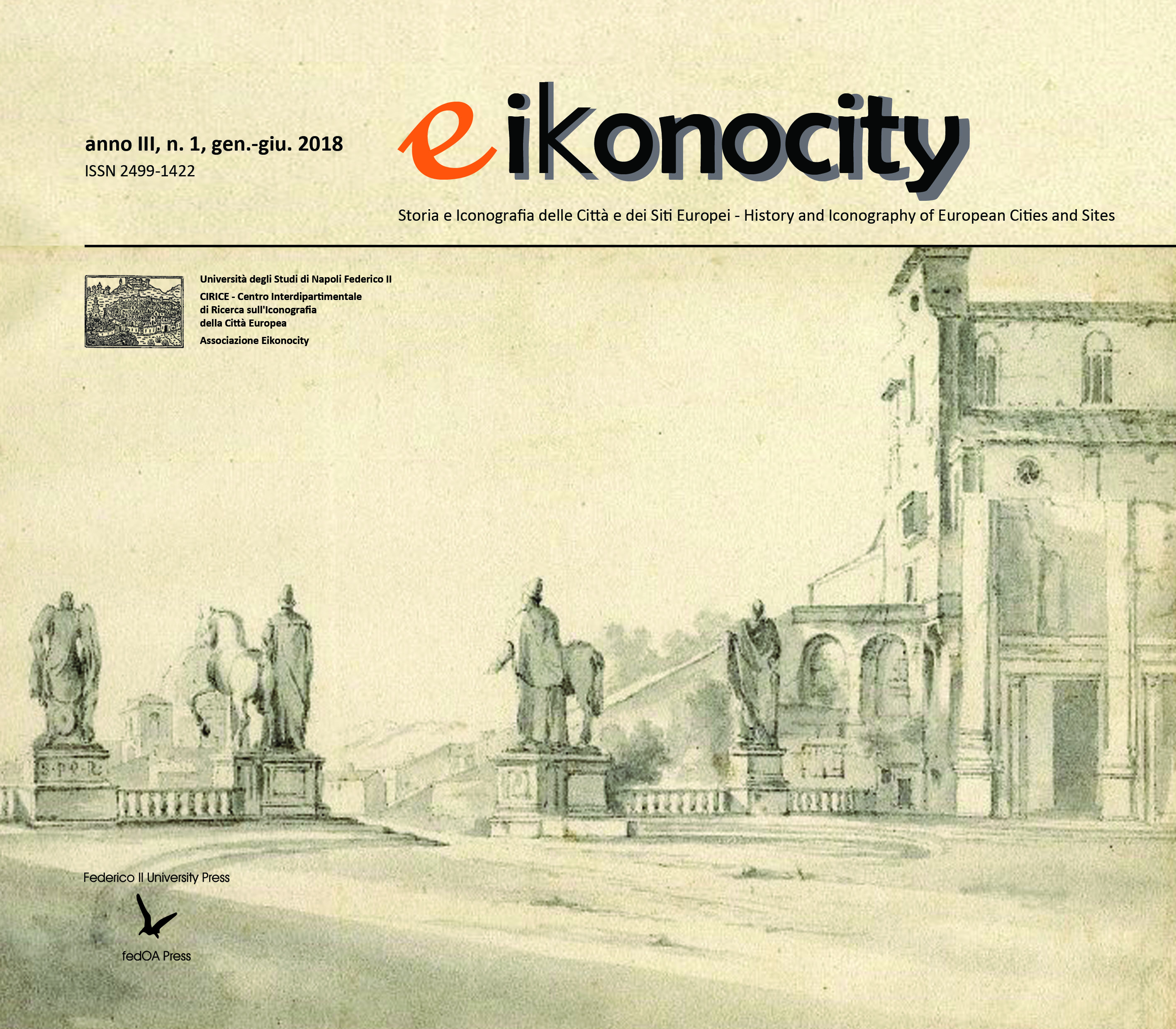L’immagine del Campidoglio e le pratiche di manipolazione visiva tra XVI e XVIII secolo
Abstract
L’analisi delle rappresentazioni del Campidoglio michelangiolesco, con le sue peculiarità geometriche e percettive, consente di identificare alcune tecniche di manipolazione visiva adottate dagli artisti, ponendole in relazione sia con la forma e l’esperienza del luogo, sia con la produzione di capricci architettonici.
The analysis of the representations of Michelangelo’s Campidoglio, with its peculiar geometrical and perceptual features, allows to identify artists’ techniques of visual manipulation, relating them to the place’s experience and form as well the production of architectural capriccio.
Downloads
Riferimenti bibliografici
ACKERMAN, J. (1988). Michelangelo Architetto. Torino: Einaudi.
ANDREANI, F. (2005). Michelangelo e l’arte della città: storia della via nova capitolina. Roma: Gangemi.
BEDON, A. (2008). Il Campidoglio: storia di un monumento civile nella Roma papale. Milano: Electa.
BETTAGNO, A., KOWALCZYK, B. A. (a cura di). (2001). Canaletto prima maniera. Milano: Mondadori Electa.
BRECCIA FRATADOCCHI, M. M., PUGLISI, P. (a cura di). (2013). Gaspar van Wittel: i disegni della collezione della Biblioteca Nazionale di Roma. Roma: Biblioteca Nazionale Centrale.
BRIGANTI, G., LAUREATI, L., TREZZANI, L. (1996). Gaspar Van Wittel e l’origine della veduta settecentesca. Milano: Electa.
BURROUGHS, Charles (1993). Michelangelo at the Campidoglio: Artistic Identity, Patronage, and Manufacture. In «Artibus et Historiae», vol. 14, n. 28, pp. 85–111.
CAFÀ, V. (2007). Palazzo Massimo alle Colonne di Baldassare Peruzzi storia di una famiglia romana e del suo palazzo in Rione Parione. Venezia: Marsilio.
COOPER, J. G. (2008). Two Drawings by Michelangelo of an Early Design for the Palazzo dei Conservatori. In «Journal of the Society of Architectural Historians», n. 67, pp. 178–203.
DESWARTE-ROSA, S. (1989). Les gravures de monuments antiques d’Antonio Salamanca, à l’origine du ‘Speculum Romanae Magnificentiae’. In «Annali di Architettura», n. 1, pp. 47–62.
FAGIOLO, M. (2012). Piante di Roma antica e moderna: l’ideologia e i metodi di rappresentazione. In «Piante di Roma dal rinascimento ai catasti». A cura di M. Bevilacqua e M. Fagiolo. Roma: Artemide, pp. 23–61.
FOSI, I. (2002). Court and city in the ceremony of the possesso in the Sixteen century. In «Court and politics in papal Rome, 1492-1700». A cura di G. Signorotto e M. A. Visceglia. Cambridge: Cambridge University Press, pp. 31–52.
HEGEMANN, W., PEETS, E. (1922). The American Vitruvius: An Architects’ Handbook of Civic Art. New York: The Architectural Book Pub.
KOZAKIEWICZ S. (1966). Il Motivo Capitolino nell'arte di Bernardo Bellotto. In «Bulletin du Musée National de Varsovie», n. 7, pp. 11–20.
KREN, T. (1982). Jan Lingelbach in Rome. In «The J. Paul Getty Museum Journal», n. 10, pp. 45–62.
LEONE, R., PIRANI, F., TITTONI, M. E., TOZZI, S. (a cura di). (2002). Il Museo di Roma racconta la città. Roma: Gangemi.
MAIER, J. (2015). Rome Measured and Imagined: Early Modern Maps of the Eternal City. Chicago: University of Chicago Press.
MARSHALL, D. R. (1993). Viviano and Niccolò Codazzi and the Baroque Architectural Fantasy. Rome: Jandi Sapi.
MORGAN, C. H. (1966). The Life of Michelangelo. New York: Reynal and Company, pp. 209–211.
MORSELLI, R., VODRET, R. (a cura di). (2005). Ritratto di una collezione. Pannini e la Galleria del Cardinale Silvio Valenti Gonzaga, catalogo della mostra. Milano: Skira.
MORTIER, R. (1974). La Poetique des ruines en France. Ses origines, ses variations de la Renaissance. Geneva: Librairie Droz.
NUTI, L. (1994). The perspective plan in the Sixteenth century. The invention of a representational language. In «The Art Bulletin», n. 76, pp. 105–128.
PORTOGHESI, P., ZEVI, B. (a cura di). (1964). Michelangiolo Architetto. Torino: Einaudi.
RIBOUILLAULT, D. (2008). Landscape ‘All’antica’ and Topographical Anachronism in Roman Fresco Painting of the Sixteenth Century. In «Journal of the Warburg and Courtauld Institutes», n. 71, pp. 211–237.
SESTIERI, G. (2015), Il Capriccio Architettonico in Italia nel XVII e XVIII secolo, Roma, etGraphiae
SMITHERS, T. (2013). ‘SPQR / CAPITOLIVM RESTITVIT’: The Renovatio of the Campidoglio and Michelangelo’s Use of Giant Order. In «Perspectives on Public Space in Rome, from Antiquity to the Present Day». A cura di G. Smith e J. Gadeyne. Farnham: Ashgate, pp. 157–186.
SUCCI, D. (n.d.), Bernardo Canal: scenografo e vedutista, in http://www.artericerca.com
TITTONI, M. E., SPEZZAFERRO, L. (1991). Campidoglio e Sisto V. Roma, Carte Segrete.
VERTOVA, L. (1995). A Late Renaissance View of Rome. In «The Burlington Magazine», n. 137, pp. 445–451.
ZORACH, R. (2008). The Virtual Tourist in Renaissance Rome: Printing and Collecting the Speculum Romanae Magnificentiae. Chicago: The University of Chicago Press.
Copyright (c) 2018 Fabio Colonnese

This work is licensed under a Creative Commons Attribution 4.0 International License.
Eikonocity pubblica in internet, ad accesso aperto, con licenza:
|
|
CCPL Creative Commons Attribuzione 4.0 |
L'autore conserva il copyright sul suo contributo, consentendo tuttavia a chiunque "di riprodurre, distribuire, comunicare al pubblico, esporre in pubblico, rappresentare, eseguire e recitare l'opera", purché siano correttamente citati l'autore e il titolo della rivista. L’autore, al momento della proposta di pubblicazione, è inoltre tenuto a dichiarare che il contenuto e l’organizzazione dell’opera è originale e non compromette in alcun modo i diritti di terzi, né gli obblighi connessi alla salvaguardia di diritti morali ed economici di altri autori o di altri aventi diritto, sia per testi, immagini, foto, tabelle, sia per altre parti di cui il contributo può essere composto. L’autore dichiara altresì di essere a conoscenza delle sanzioni previste dal codice penale e dalle leggi speciali per l’ipotesi di falsità in atti ed uso di atti falsi, e che pertanto Eikonocity è esente da qualsiasi responsabilità di qualsivoglia natura, civile, amministrativa o penale, e sarà dall'autore tenuta indenne da qualsiasi richiesta o rivendicazione da parte di terzi.




